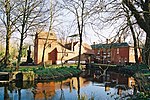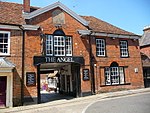Andover railway station (England)
1854 establishments in EnglandAndover, HampshireDfT Category C1 stationsFormer London and South Western Railway stationsPages with no open date in Infobox station ... and 4 more
Railway stations in Great Britain opened in 1854Railway stations in HampshireRailway stations served by South Western RailwayUse British English from November 2015

Andover railway station serves the town of Andover, Hampshire, England. The station is served and operated by South Western Railway. It is 66 miles 19 chains (106.6 km) down the line from London Waterloo on the West of England Main Line. According to the Office of Rail Regulation statistics on rail trends for the year 2019-20, 1,152,576 exits and entries were made at Andover rail station, making it the 15th most used rail station in the county of Hampshire (including the unitary authority areas of Portsmouth City Council and Southampton City Council).
Excerpt from the Wikipedia article Andover railway station (England) (License: CC BY-SA 3.0, Authors, Images).Andover railway station (England)
Station Approach, Test Valley Saxon Fields
Geographical coordinates (GPS) Address Nearby Places Show on map
Geographical coordinates (GPS)
| Latitude | Longitude |
|---|---|
| N 51.212 ° | E -1.492 ° |
Address
Andover
Station Approach
SP10 3RN Test Valley, Saxon Fields
England, United Kingdom
Open on Google Maps








